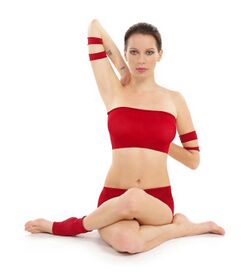Religion:Gomukhasana
Gomukhasana (Sanskrit: गौमुखासन; IAST: Gomukhāsana) or Cow Face Pose[1] is a seated asana in hatha yoga and modern yoga as exercise, sometimes used for meditation.
Etymology and origins
The name comes from the Sanskrit गौ go meaning "cow", मुख mukha meaning "face" or "mouth",[2] and आसन āsana meaning "posture" or "seat".[3] The crossed legs are said to look like a cow's mouth, while the bent elbows supposedly look like a cow's ears.[1]
The pose is ancient as it is described in the Darshana Upanishad (3.3–4), written around the 4th century.[4][5] For instance, it is listed and described within the 84 asanas in the 17th-century Haṭha Ratnāvalī (3.7–20).[5][6] However, the current form of Gomukhasana with the hands behind the back is mentioned only in such ancient tantric texts as the Ahirbudhnya Samhita.[5] It is sometimes used for meditation and pranayama.[7]
Description
The pose is entered from kneeling by crossing the legs; the heel of the upper leg is tucked in under the lower thigh near the buttock. The arm on the lower leg side is raised, the forearm bent down, while the other arm reaches down behind the back, the forearm bent up, so the hands can clasp between the shoulder blades.[8]
The sitting position can be modified either by putting a folded blanket on the heels, and if need be also one beneath them.[8]
The pose stretches the shoulders. The hand position can be modified using a strap to extend the reach for those who cannot bring the hands together behind the back.[1][9] The pose is contra-indicated for people with a rotator cuff injury.[9]
Preparatory poses for Gomukhasana include Baddha Konasana and Garudasana.[1] Counter poses include Dandasana, Paschimottanasana, and Purvottanasana.[1]
See also
- List of asanas
References
- ↑ 1.0 1.1 1.2 1.3 1.4 "Cow Face Pose". 28 August 2007. http://www.yogajournal.com/poses/689.
- ↑ "Gomukhasana A". Ashtanga Yoga. http://www.ashtangayoga.info/practice/asana-vinyasa-series/intermediate-series-nadi-shodhana/item/gomukhasana-a/.
- ↑ Sinha, S. C. (1996). Dictionary of Philosophy. Anmol Publications. p. 18. ISBN 978-81-7041-293-9. https://books.google.com/books?id=-zzRvh1fRzEC&pg=PA18.
- ↑ The Yoga Upanishads. Adyar, Madras: The Adyar Library. 1938. p. 124. https://archive.org/stream/TheYogaUpanishads/TheYogaUpanisadsSanskritEngish1938#page/n3/mode/2up.
- ↑ 5.0 5.1 5.2 Sriharisukesh, N.; Pailoor, Subramanya (2019). "A review of asanas referenced in ancient texts and a brief comparative study of selected asanas". International Journal of Sanskrit Research 5 (4): 270–273. ISSN 2394-7519. https://www.anantaajournal.com/archives/2019/vol5issue4/PartE/5-4-48-526.pdf.
- ↑ Mallinson, James; Singleton, Mark (2017). Roots of Yoga. Penguin Classics. London: Penguin Books. pp. 116–119. ISBN 978-0-241-25304-5. OCLC 928480104.
- ↑ "Gomukhasana (Cow Face Posture)". The Divine Life Society. 2011. http://sivanandaonline.org/public_html/?cmd=displaysection§ion_id=1261. "Hence, this Asana is suitable for the practice of Pranayama. Ordinarily you can sit at all times in this Asana for long meditation also."
- ↑ 8.0 8.1 Mehta, Silva; Mehta, Mira; Mehta, Shyam (1990). Yoga: The Iyengar Way. Dorling Kindersley. p. 56. ISBN 978-0-86318-420-8.
- ↑ 9.0 9.1 Swanson, Ann (2019). Science of yoga : understand the anatomy and physiology to perfect your practice. New York, New York: DK Publishing. p. 60. ISBN 978-1-4654-7935-8. OCLC 1030608283.
Further reading
- Iyengar, B. K. S. (2005). Illustrated Light On Yoga. HarperCollin. ISBN 978-81-7223-606-9. https://books.google.com/books?id=pbx5AAAACAAJ.
- Saraswati, Swami Satyananda (1996). Asana Pranayama Mudra Bandha. Munger, Bihar: Yoga Publications Trust. ISBN 978-81-86336-14-4. http://www.znakovi-vremena.net/en/Swami-Satyananda-Saraswati---Asana-Pranayama-Mudra-Bandha.pdf. Retrieved 2019-01-12.
 |



